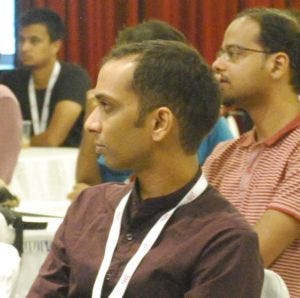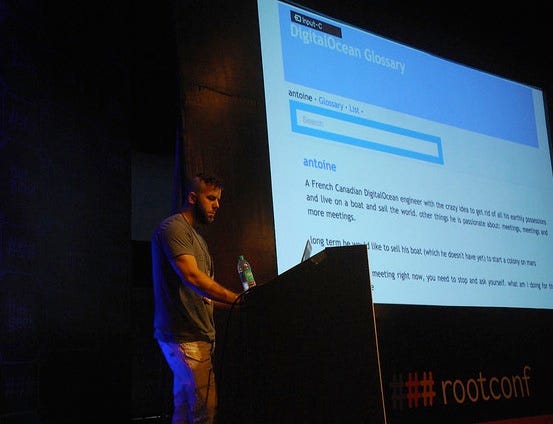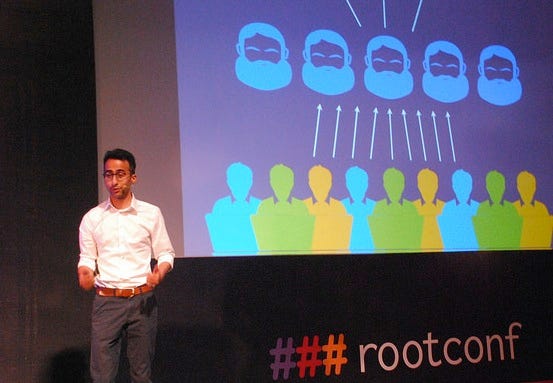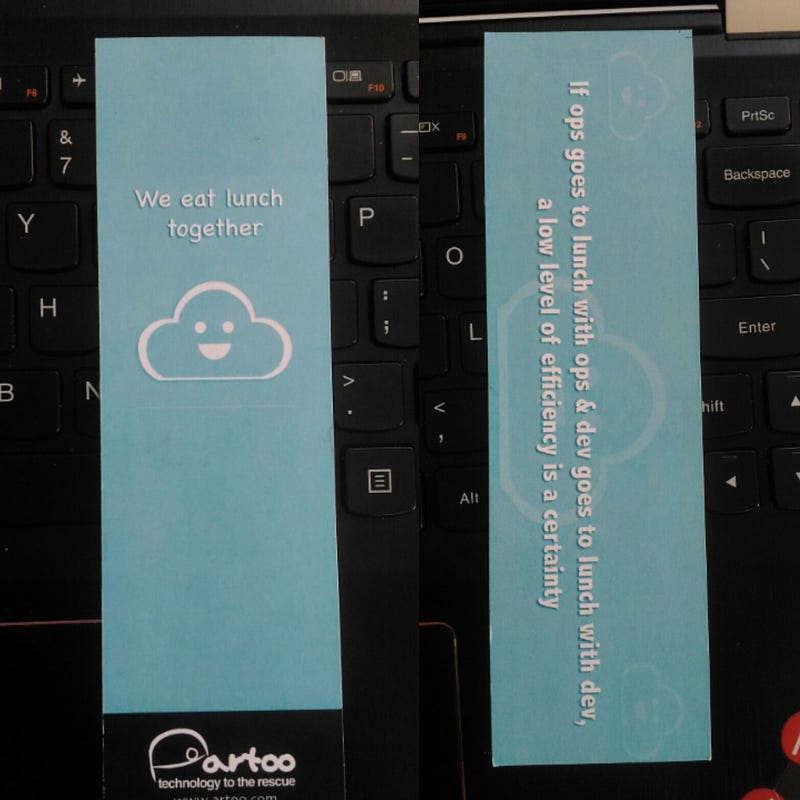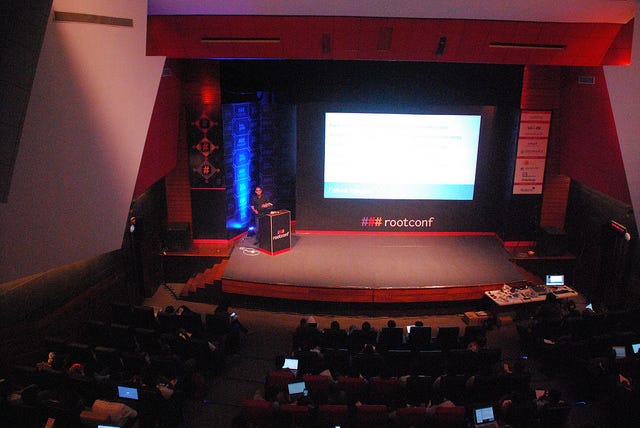
Rootconf is an annual conference on DevOps and Cloud infrastructure spearheaded by HasGeek, which regularly conducts tech conferences and workshops. We missed an opportunity to showcase things at #rootconf about we have learned on managing Artoo infrastructure over the last year, but Shameer and I were excited to join in for couple of fun days. In addition to learning new things, we were looking forward to interact with like-minded people who were doing exciting stuff around DevOps and Cloud.
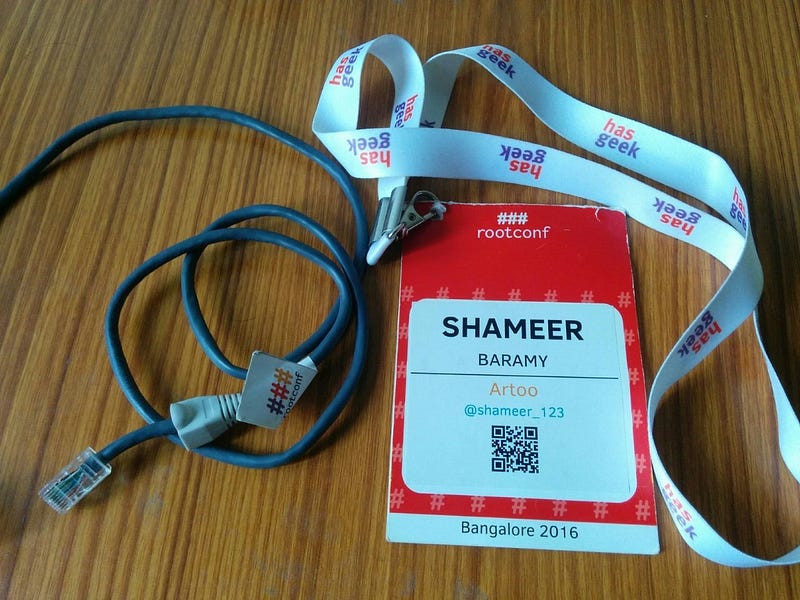
RJ45 cable used as Rootconf’s ID tag.
I am not sure if this has already happened at other HasGeek events, but this year’s rootconf had a few interesting things to offer. The RJ45 cable was used as the ID tag holder, and a swarm of new-age Bangalore food start-ups served us food in lieu of food tickets.
People often complain about food at large events; however, our options were plenty and delicious at this year’s Rootconf.
Of the talks lined up at the event, I suppose there was a concerted effort to showcase higher quality talks on varied subjects, and speakers across the globe shared their experiences and interesting projects with us.
It was delightful to be a part of some good panel discussions on DevOps and databases in parallel to the talks stream. People shared their DevOps experiences with regards to system failures, disasters, and good design practices. At Artoo, we are adding more components and functionality to our software stack and have been looking around for best practices around system design, handling failures, performance and stability of the whole platform.
Some of the key takeaways from the conference around these ideas were:
- Embrace failure and try to build systems that work even amid systemic breakdowns: This espousal runs contrary to what a new engineer would try to do: write code for all edge cases and try to control all parts of the system. This was a talk by Antoine (linked below), where he spoke about how we should go about planning systems considering that they would always keep crashing or running into some issues and yet how to continue achieving their functional goals. It spoke about managing communication and state across components in a system.
- Simplicity (code, organisation): Continuing from the previous talk about simple components and communication, we then got into simplicity in the organisation communication and structures. The interaction between developers and operations at Snapdeal to maximize quality and output was captured very well by Yagnik in his talk. He sympathised with the DevOps crowd quite well and had a light-hearted take on this bitter-sweet relationship. For instance, he presented a slide where DevOps people were identified as faces with a blank look and long beard (When he said this and I looked around at the audience, there were quite a few people who met this description and were now smiling).
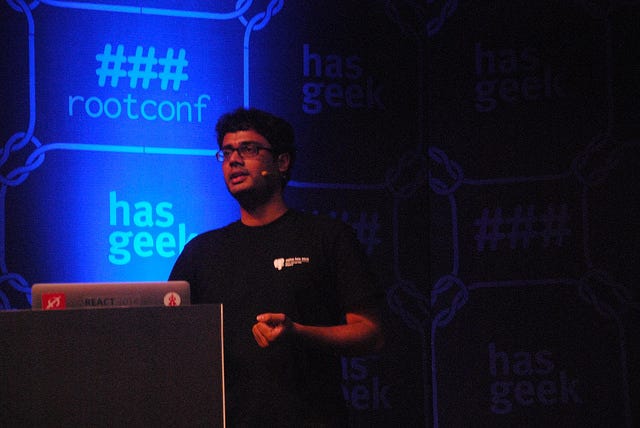
- Look for general problem solvers (example: SRE): This was from the DevOps panel discussions about how to approach and acquaint DevOps for people new to the field, how to hire people, etc. There were also brief references to Google’s Site Reliability Engineer role specs, which were released and made public recently. The emphasis here was on looking more for general problem solvers and moulding them rather than looking for an experienced full-time rockstar DevOps person, especially for startups. It was more of a debate on whether one should hire a person with pure skills on the infrastructure part or get people with superior cognitive abilities. Aditya Pattawari from Browserstack summarized it in a few words, “If we are hiring 10 people for a team of DevOps, we should have 2 of them who are completely experienced and have worked on a great deal of things in infrastructure, whereas the remaining 8 can be the problem solvers with high cognitive abilities, who are quick enough to grasp teachings from the 2 experienced ones.” “Dont rely on the 2 guys to stay for long though,” he chuckled.
I was thoroughly impressed by the sheer depth of knowledge of the people around me. What personally intrigued me was their capacity to unlearn and relearn. After the talks, we spoke to some interesting people and even distributed our fancy new Artoo bookmark. A few of them had specially flown down from the across the globe for this event, and we shared and discussed our experiences.
Artoo bookmarks.
This year’s Rootconf offered interesting insights into DevOps, food, failure, and simplicity. Look forward to more such good stuff in the future.
Inspiration from: https://rootconf.in/2016/
My personal favorite talks from the conference were:
- Crash-only software (Digital Ocean, Antoine Grondin): A talk on what crash only software is, why you want it and how to implement it, with examples from large scale deployments at DigitalOcean on how to design for graceful handling of failures.
- An extension to the chaos engineering from Netflix (Netflix, Diptanu): The talk introduces Chaos Engineering and focuses on how complex distributed systems fail in large scale internet services. It discuss patterns and various techniques for designing highly aperatiovailable and resilient distributed systems that can heal from transient failures.
- Managing the developer to ops communications (Snapdeal, Yagnik): The talk is intended to help understand how to scale operations and developers with the help of cultural and process changes that allow you to innovate faster with higher accountability and reliability.
- Continuous deployment at scale (Etsy, Premshree Pillai): Learning about optimizing everyone’s productivity and happiness while building products at scale, through software tooling and culture.
- PostgreSQL and MySQL war stories (Srihari and Colin): The first talk is about the failure scenarios we designed for the Postgres database cluster, the times when the designed system failed, and what we learnt from them. The second talk is about the MySQL ecosystem, which offers plenty of solution albeit with tradeoffs and how to look at all of the alternatives in an unbiased nature.

For the complete list of talks and videos at the Rootconf
https://www.youtube.com/playlist?list=PL279M8GbNsevAmMGz5SKSGDOQdQdlhBcq
For further reading on rootconf:
https://kushaldas.in/posts/event-report-rootconf-2016.html
About the author:
Shrivatsa Swadi | A Mobile Engineer (Geek)
Shrivatsa is a full stack developer at Artoo who supervises and mentors the engineering team. He is passionate about using technology to bring changes on the ground, especially to benefit those outside the grid.
